Genome-Wide Identification and Expression Analysis Reveals the B3 Superfamily Involved in Embryogenesis and Hormone Responses in Dimocarpus longan Lour.
Abstract
:1. Introduction
2. Results
2.1. Genome-Wide Identification of B3 Genes in Longan
2.2. Phylogenetic Relationship and Synteny Analysis of DlB3 Genes
2.3. Conserved Motifs, Structural Domains, and Gene Structure Analysis
2.4. Analysis Related to Cis-Acting Elements and Transcription Start Site in the DlB3 Promoters
2.5. Analysis of DlB3 Protein Interactions
2.6. RNA-Seq Revealed the Expression Profiles of Longan DlB3 Genes in Different Tissues and Treatments
2.7. Expression Analysis of the DlB3 Family during Early SE
2.8. Analysis of the Expression Patterns of the DlB3 Family at Different Development Stages of Zygotic Embryos
2.9. Analysis of the Expression Patterns of the DlB3 Family under Different Exogenous Hormone Treatments
2.10. Subcellular Localization of DlLEC2 and DlFUS3
3. Discussion
3.1. DlB3 Family May Be Evolutionarily Conservative and Functionally Diverse
3.2. DlB3s May Be Involved in Longan Embryogenesis and Organ Morphogenesis
3.3. DlB3s Were Involved in Longan SE through Hormones and Stress Response
4. Materials and Methods
4.1. Plant Materials and Treatments
4.2. Identification of the B3 Superfamily in Longan
4.3. Phylogenetic Evolution and Synteny Analysis of DlB3s
4.4. Analysis of Conserved Motifs, Structural Domains, and Gene Structure of DlB3s
4.5. Analysis of Cis-Acting Elements and Transcription Start Site of DlB3s
4.6. Protein Interaction Analysis of DlB3s
4.7. Expression Analysis of the DlB3 Family at the Early Stage of SE, Different Tissues, Different Light Quality, and Different Temperatures
4.8. Subcellular Localization Analysis
4.9. RNA Extraction and qRT-PCR Analysis
5. Conclusions
Supplementary Materials
Author Contributions
Funding
Institutional Review Board Statement
Informed Consent Statement
Data Availability Statement
Acknowledgments
Conflicts of Interest
Abbreviations
| Dl | Dimocarpus longan Lour. |
| aa | amino acids |
| NEC | non-embryogenic callus |
| EC | embryogenic callus |
| ICpEC | incomplete compact pro-embryogenic cultures |
| GE | globular embryos |
| SE | somatic embryogenesis |
| DNA | deoxyribonucleic acid |
| RNA | ribonucleic acid |
| cDNA | complementary DNA |
| qPCR | quantitative real-time PCR |
| CDS | coding sequence |
| UTR | untranslated regions |
| bp | base pairs |
| μL | microliter |
| mL | milliliter |
| g | gram |
| d | day |
| h | hour |
| min | minute |
| s | second |
| rpm | revolutions per minute |
| FPKM | Fragments Per Kilo-base of exon per Million fragments mapped |
| 2,4-D | 2,4-Dichlorophenoxyacetic acid |
| IAA | Indole-3-acetic acid |
| ABA | abscisic acid |
| GA | gibberellin |
| SA | salicylic acid |
| MeJa | methyl jasmonate |
| NPA | N-1-naphthylphthalamic acid |
| PP333 | paclobutrazol |
| DAPI | 4′,6-diamidino-2-phenylindol |
| EGFP | Enhanced Green Fluorescent Protein |
| RNA-seq | RNA sequencing |
References
- Swaminathan, K.; Peterson, K.; Jack, T. The plant B3 superfamily. Trends Plant Sci. 2008, 13, 647–655. [Google Scholar] [CrossRef] [PubMed]
- McCarty, D.R.; Hattori, T.; Carson, C.B.; Vasil, V.; Lazar, M.; Vasil, I.K. The Viviparous-1 developmental gene of maize encodes a novel transcriptional activator. Cell 1991, 66, 895–905. [Google Scholar] [CrossRef] [PubMed]
- Suzuki, M.; Kao, C.Y.; McCarty, D.R. The conserved B3 domain of VIVIPAROUS1 has a cooperative DNA binding activity. Plant Cell 1997, 9, 799–807. [Google Scholar] [CrossRef] [PubMed]
- Liu, Y.; Dong, Z. The Function and Structure of Plant B3 Domain Transcription Factor. Mol. Plant Breed. 2017, 15, 1868–1873. [Google Scholar] [CrossRef]
- Yamasaki, K.; Kigawa, T.; Inoue, M.; Tateno, M.; Yamasaki, T.; Yabuki, T.; Aoki, M.; Seki, E.; Matsuda, T.; Tomo, Y.; et al. Solution structure of the B3 DNA binding domain of the Arabidopsis cold-responsive transcription factor RAV1. Plant Cell 2004, 16, 3448–3459. [Google Scholar] [CrossRef]
- Tsukagoshi, H.; Morikami, A.; Nakamura, K. Two B3 domain transcriptional repressors prevent sugar-inducible expression of seed maturation genes in Arabidopsis seedlings. Proc. Nat. Acad. Sci. USA 2007, 104, 2543–2547. [Google Scholar] [CrossRef]
- Guangyu, L.; Lingfei, Y.; Xinbo, C. Research progress of Arabidopsis B3 transcription factor gene superfamily. Chem. Life 2013, 33, 287–293. [Google Scholar] [CrossRef]
- Wu, J.; Yu, S.; Liu, Z.; Fu, Y.; Zhou, M. Genome Identification and Expression Pattern Analysis of Phyllostachys edulis B3 Family. J. Agric. Biotechnol. 2019, 27, 43–54. [Google Scholar]
- Romanel, E.; Schrago, C.G.; Couñago, R.M.; Russo, C.A.M.; Alves-Ferreira, M. Evolution of the B3 DNA Binding Superfamily: New Insights into REM Family Gene Diversification. PLoS ONE 2009, 4, e5791. [Google Scholar] [CrossRef]
- Sun, T.; Wang, D.; Gong, D.; Chen, L.; Chen, Y.; Sun, Y. Genome-wide Identification and Bioinformatic Analysis of B3 Superfamily in Tomato. J. Plant Genet. Resour. 2015, 16, 806–814. [Google Scholar] [CrossRef]
- Liu, Z.; Ge, X.-X.; Wu, X.-M.; Xu, Q.; Atkinson, R.G.; Guo, W.-W. Genome-wide analysis of the citrus B3 superfamily and their association with somatic embryogenesis. BMC Genom. 2020, 21, 305. [Google Scholar] [CrossRef] [PubMed]
- Ruan, C.C.; Chen, Z.; Hu, F.C.; Fan, W.; Wang, X.H.; Guo, L.J.; Fan, H.Y.; Luo, Z.W.; Zhang, Z.L. Genome-wide characterization and expression profiling of B3 superfamily during ethylene-induced flowering in pineapple (Ananas comosus L.). BMC Genom. 2021, 22, 561. [Google Scholar] [CrossRef] [PubMed]
- Verma, S.; Bhatia, S. A comprehensive analysis of the B3 superfamily identifies tissue-specific and stress-responsive genes in chickpea (Cicer arietinum L.). 3 Biotech 2019, 9, 346. [Google Scholar] [CrossRef] [PubMed]
- Ren, C.; Wang, H.; Zhou, Z.; Jia, J.; Zhang, Q.; Liang, C.; Li, W.; Zhang, Y.; Yu, G. Genome-wide identification of the B3 gene family in soybean and the response to melatonin under cold stress. Front. Plant Sci. 2023, 13, 1091907. [Google Scholar] [CrossRef] [PubMed]
- Ellis, C.M.; Nagpal, P.; Young, J.C.; Hagen, G.; Guilfoyle, T.J.; Reed, J.W. AUXIN RESPONSE FACTOR1 and AUXIN RESPONSE Factor2 regulate senescence and floral organ abscission in Arabidopsis thaliana. Development 2005, 132, 4563–4574. [Google Scholar] [CrossRef]
- Shin, R.; Burch, A.Y.; Huppert, K.A.; Tiwari, S.B.; Murphy, A.S.; Guilfoyle, T.J.; Schachtman, D.P. The Arabidopsis transcription factor MYB77 modulates auxin signal transduction. Plant Cell 2007, 19, 2440–2453. [Google Scholar] [CrossRef] [PubMed]
- Wenzel, C.L.; Marrison, J.; Mattsson, J.; Haseloff, J.; Bougourd, S.M. Ectopic divisions in vascular and ground tissues of Arabidopsis thaliana result in distinct leaf venation defects. J. Exp. Bot. 2012, 63, 5351–5364. [Google Scholar] [CrossRef] [PubMed]
- Lianzhe, W.; Lijun, X.; Jiankang, L.; Yuan, W.; Shuai, Z.; Bingbing, L. Cloning and Expression Analysis of B3 Group Transcription Factor REM-1 Gene in Wheat. Mol. Plant Breed. 2019, 17, 4853–4858. [Google Scholar] [CrossRef]
- Wu, M.-F.; Tian, Q.; Reed, J.W. Arabidopsis microRNA167 controls patterns of ARF6 and ARF8 expression, and regulates both female and male reproduction. Development 2006, 133, 4211–4218. [Google Scholar] [CrossRef]
- Chandan, R.; Kumar, R.; Swain, D.; Ghosh, S.; Bhagat, P.; Patel, S.; Bagler, G.; Sinha, A.; Jha, G. RAV1 family members function as transcriptional regulators and play a positive role in plant disease resistance. Plant J. 2023, 114, 39–54. [Google Scholar] [CrossRef]
- Woo, H.; Kim, J.; Kim, J.-Y.; Kim, J.; Lee, U.; Song, I.-J.; Kim, J.-H.; Lee, H.-Y.; Nam, H.; Lim, P. The RAV1 transcription factor positively regulates leaf senescence in Arabidopsis. J. Exp. Bot. 2010, 61, 3947–3957. [Google Scholar] [CrossRef] [PubMed]
- Hu, Y.X.; Wang, Y.H.; Liu, X.F.; Li, J.Y. Arabidopsis RAV1 is down-regulated by brassinosteroid and may act as a negative regulator during plant development. Cell Res. 2004, 14, 8–15. [Google Scholar] [CrossRef] [PubMed]
- Mylne, J.; Mas, C.; Hill, J. NMR assignment and secondary structure of the C-terminal DNA binding domain of Arabidopsis thaliana VERNALIZATION1. Biomol. NMR Assign. 2011, 6, 5–8. [Google Scholar] [CrossRef]
- Levy, Y.Y.; Mesnage, S.; Mylne, J.S.; Gendall, A.R.; Dean, C. Multiple roles of Arabidopsis VRN1 in vernalization and flowering time control. Science 2002, 297, 243–246. [Google Scholar] [CrossRef] [PubMed]
- Sugliani, M.; Brambilla, V.; Clerkx, E.J.M.; Koornneef, M.; Soppe, W.J.J. The conserved splicing factor SUA controls alternative splicing of the developmental regulator ABI3 in Arabidopsis. Plant Cell 2010, 22, 1936–1946. [Google Scholar] [CrossRef] [PubMed]
- Yang, Z.; Liu, X.; Wang, K.; Li, Z.; Jia, Q.; Zhao, C.; Zhang, M. ABA-INSENSITIVE 3 with or without FUSCA3 highly up-regulates lipid droplet proteins and activates oil accumulation. J. Exp. Bot. 2021, 73, 2077–2092. [Google Scholar] [CrossRef] [PubMed]
- Chiu, R.S.; Nahal, H.; Provart, N.J.; Gazzarrini, S. The role of the Arabidopsis FUSCA3transcription factor during inhibition of seed germination at high temperature. BMC Plant Biol. 2012, 12, 15. [Google Scholar] [CrossRef]
- Zhou, X.; Weng, Y.; Su, W.; Ye, C.; Qu, H.; Li, Q. Uninterrupted embryonic growth leading to viviparous propagule formation in woody mangrove. Front. Plant Sci. 2023, 13, 1061747. [Google Scholar] [CrossRef]
- Liu, X.; Li, N.; Chen, A.; Saleem, N.; Jia, Q.; Zhao, C.; Li, W.; Zhang, M. FUSCA3-induced AINTEGUMENTA-like 6 manages seed dormancy and lipid metabolism. Plant Physiol. 2023, 193, 1091–1108. [Google Scholar] [CrossRef]
- Horstman, A.; Bemer, M.; Boutilier, K. A transcriptional view on somatic embryogenesis. Regeneration 2017, 4, 201–216. [Google Scholar] [CrossRef]
- Shiyi, W.; Yizi, H.; Zhouyang, L.; Huahong, H.; Erpei, L. Research progress in plant somatic embryogenesis and its molecular regulation mechanism. J. Zhejiang A F Univ. 2022, 39, 223–232. [Google Scholar]
- Horstman, A.; Li, M.; Heidmann, I.; Weemen, M.; Chen, B.; Muino, J.M.; Angenent, G.C.; Boutilier, K. The BABY BOOM Transcription Factor Activates the LEC1-ABI3-FUS3-LEC2 Network to Induce Somatic Embryogenesis. Plant Physiol. 2017, 175, 848–857. [Google Scholar] [CrossRef] [PubMed]
- Wang, H.; Guo, J.; Lambert, K.N.; Lin, Y. Developmental control of Arabidopsis seed oil biosynthesis. Planta 2007, 226, 773–783. [Google Scholar] [CrossRef] [PubMed]
- Suzuki, M.; Wang, H.; McCarty, D.R. Repression of the LEAFY COTYLEDON 1/B3 Regulatory Network in Plant Embryo Development by VP1/ABSCISIC ACID INSENSITIVE 3-LIKE B3 Genes1. Plant Physiol. 2006, 143, 902–911. [Google Scholar] [CrossRef] [PubMed]
- Zhao, X.; Liu, T.; Huang, M.J.; Zhang, J.W.; Tuluhong, G.; Zhang, X. Cloning and Activity Assay of Somatic Embryogenesis-specific Gene GbLEC2 Promoter in Gossypium barbadense. J. Agric. Biotechnol. 2023, 31, 695–703. [Google Scholar]
- Braybrook, S.A.; Harada, J.J. LECs go crazy in embryo development. Trends Plant Sci. 2008, 13 12, 624–630. [Google Scholar] [CrossRef]
- Brand, A.; Quimbaya, M.A.; Tohme, J.; Chavarriaga-Aguirre, P. Arabidopsis LEC1 and LEC2 Orthologous Genes Are Key Regulators of Somatic Embryogenesis in Cassava. Front. Plant Sci. 2019, 10, 673. [Google Scholar] [CrossRef]
- Wenyu, L.; Wei, C.; Ruifeng, S.; Feng, Z. Advances in embryo development of longan. Subtrop. Plant Sci. 2004, 33, 65–68. [Google Scholar]
- Chen, Y.; Lin, X.; Lai, Z. Advances in Somatic Embryogenesis of Dimocarpus longan Lour. Chin. J. Trop. Crop. 2020, 41, 1990–2002. [Google Scholar]
- Radoeva, T.; Vaddepalli, P.; Zhang, Z.; Weijers, D. Evolution, Initiation, and Diversity in Early Plant Embryogenesis. Dev. Cell 2019, 50, 533–543. [Google Scholar] [CrossRef]
- Lai, Z.; Chen, Z. Somatic embryogenesis of high frequency from longan embryogenic call. J. Fujian Agric. For. Univ. Nat. Sci. Ed. 1997, 26, 271–276. [Google Scholar]
- Lai, Z.; Pan, L.; Chen, Z. Establishment and maintenance of longan embryogenic cell lines. J. Fujian Agric. For. Univ. Nat. Sci. Ed. 1997, 2, 33–40. [Google Scholar]
- Lin, Y.; Min, J.; Lai, R.; Wu, Z.; Chen, Y.; Yu, L.; Cheng, C.; Jin, Y.; Tian, Q.; Liu, Q.; et al. Genome-wide sequencing of longan (Dimocarpus longan Lour.) provides insights into molecular basis of its polyphenol-rich characteristics. GigaScience 2017, 6, 1–14. [Google Scholar] [CrossRef] [PubMed]
- Chen, Y.; Xie, D.; Ma, X.; Xue, X.; Liu, M.; Xiao, X.; Lai, C.W.J.; Xu, X.; Chen, X.; Chen, Y.; et al. Genome-wide Hi-C analysis reveals hierarchical chromatin interactions during early somatic embryogenesis. Plant Physiol. 2023, 193, 555–577. [Google Scholar] [CrossRef] [PubMed]
- Zhang, S.; Zhu, C.; Zhang, X.; Liu, M.; Xue, X.; Lai, C.; Xuhan, X.; Chen, Y.; Zhang, Z.; Lai, Z.; et al. Single-cell RNA sequencing analysis of the embryogenic callus clarifies the spatiotemporal developmental trajectories of the early somatic embryo in Dimocarpus longan. Plant J. 2023, 115, 1277–1297. [Google Scholar] [CrossRef] [PubMed]
- Xu, X.; Zhang, C.; Xu, X.; Cai, R.; Guan, Q.; Chen, X.; Chen, Y.; Zhang, Z.; XuHan, X.; Lin, Y.; et al. Riboflavin mediates m6A modification targeted by miR408, promoting early somatic embryogenesis in longan. Plant Physiol. 2023, 192, 1799–1820. [Google Scholar] [CrossRef] [PubMed]
- Suzuki, M.; McCarty, D.R. Functional symmetry of the B3 network controlling seed development. Curr. Opin. Plant Biol. 2008, 11, 548–553. [Google Scholar] [CrossRef] [PubMed]
- Tong, Z.; Zhang, Y.; Wang, L.; Li, A.; Wang, W.; Wang, P.; Liu, H.; Liu, Q.; Wang, C. Genome wide identification and expression pattern analysis of B3 gene family in maize. Pratacult. Sci. 2023, 40, 2556–2570. [Google Scholar]
- Shi, R.; Zhang, D.; Sun, Z.; Liu, Z.; Xie, M.; Zhang, Y.; Ma, Z.; Wang, X. Genome-wide identification and expression analysis of REM gene family in Gossypium hirsutum. Cotton Sci. 2021, 33, 95–111. [Google Scholar]
- Jain, M.; Khurana, P.; Tyagi, A.K.; Khurana, J.P. Genome-wide analysis of intronless genes in rice and Arabidopsis. Funct. Int. Genom. 2008, 8, 69–78. [Google Scholar] [CrossRef]
- Rogozin, I.B.; Sverdlov, A.V.; Babenko, V.N.; Koonin, E.V. Analysis of evolution of exon-intron structure of eukaryotic genes. Brief. Bioinf. 2005, 6, 118–134. [Google Scholar] [CrossRef]
- Hernandez-Garcia, C.M.; Finer, J.J. Identification and validation of promoters and cis-acting regulatory elements. Plant Sci. 2014, 217–218, 109–119. [Google Scholar] [CrossRef] [PubMed]
- Stone, S.L.; Kwong, L.W.; Yee, K.M.; Pelletier, J.; Lepiniec, L.; Fischer, R.L.; Goldberg, R.B.; Harada, J.J. LEAFY COTYLEDON2 encodes a B3 domain transcription factor that induces embryo development. Proc. Natl. Acad. Sci. USA 2001, 98, 11806–11811. [Google Scholar] [CrossRef] [PubMed]
- Harada, J.J. Role of Arabidopsis LEAFY COTYLEDON genes in seed development. J. Plant Physiol. 2001, 158, 405–409. [Google Scholar] [CrossRef]
- Teng, M.; Love, M.I.; Davis, C.A.; Djebali, S.; Dobin, A.; Graveley, B.R.; Li, S.; Mason, C.E.; Olson, S.; Pervouchine, D.; et al. A benchmark for RNA-seq quantification pipelines. Genome Biol. 2016, 17, 74. [Google Scholar] [CrossRef] [PubMed]
- Robert, C.; Watson, M. Errors in RNA-Seq quantification affect genes of relevance to human disease. Genome Biol. 2015, 16, 1–16. [Google Scholar] [CrossRef] [PubMed]
- Everaert, C.; Luypaert, M.; Maag, J.L.V.; Cheng, Q.X.; Dinger, M.E.; Hellemans, J.; Mestdagh, P. Benchmarking of RNA-sequencing analysis workflows using whole-transcriptome RT-qPCR expression data. Sci. Rep. 2017, 7, 1559. [Google Scholar] [CrossRef] [PubMed]
- Ckurshumova, W.; Smirnova, T.; Marcos, D.; Zayed, Y.; Berleth, T. Irrepressible MONOPTEROS/ARF5 promotes de novo shoot formation. New Phytol. 2014, 204, 556–566. [Google Scholar] [CrossRef]
- Tao, Z.; Hu, H.; Luo, X.; Jia, B.; Du, J.; He, Y. Embryonic resetting of the parental vernalized state by two B3 domain transcription factors in Arabidopsis. Nat. Plants 2019, 5, 424–435. [Google Scholar] [CrossRef]
- Nagpal, P.; Ellis, C.M.; Weber, H.; Ploense, S.E.; Barkawi, L.S.; Guilfoyle, T.J.; Hagen, G.; Alonso, J.M.; Cohen, J.D.; Farmer, E.E.; et al. Auxin response factors ARF6 and ARF8 promote jasmonic acid production and flower maturation. Development 2005, 132, 4107–4118. [Google Scholar] [CrossRef]
- Kumar, R.; Tyagi, A.K.; Sharma, A.K. Genome-wide analysis of auxin response factor (ARF) gene family from tomato and analysis of their role in flower and fruit development. Mol. Genet. Genom. 2011, 285, 245–260. [Google Scholar] [CrossRef]
- Müller, B.; Sheen, J. Cytokinin and auxin interaction in root stem-cell specification during early embryogenesis. Nature 2008, 453, 1094–1097. [Google Scholar] [CrossRef] [PubMed]
- Yan, F. Regulation of Embryogenic Callus Proliferation and Physiological Characteristics of Picea Pungens by 2,4-D and GS. Master’s Thesis, Jilin Agricultural University, Changchun, China, 2022. [Google Scholar]
- Su, Y.H.; Su, Y.X.; Liu, Y.; Zhang, X.S. Abscisic acid is required for somatic embryo initiation through mediating spatial auxin response in Arabidopsis. Plant Growth Regul. 2013, 69, 167–176. [Google Scholar] [CrossRef]
- Waadt, R.; Seller, C.A.; Hsu, P.-K.; Takahashi, Y.; Munemasa, S.; Schroeder, J.I. Plant hormone regulation of abiotic stress responses. Nat. Rev. Mol. Cell Biol. 2022, 23, 680–694. [Google Scholar] [CrossRef] [PubMed]
- Tang, M.; Gao, X.; Meng, W.; Lin, J.; Zhao, G.; Lai, Z.; Lin, Y.; Chen, Y. Transcription factors NF-YB involved in embryogenesis and hormones responses in Dimocarpus Longan Lour. Front. Plant Sci. 2023, 14, 1255436. [Google Scholar] [CrossRef] [PubMed]
- Braybrook, S.A.; Stone, S.L.; Park, S.; Bui, A.Q.; Le, B.H.; Fischer, R.L.; Goldberg, R.B.; Harada, J.J. Genes directly regulated by LEAFY COTYLEDON2 provide insight into the control of embryo maturation and somatic embryogenesis. Proc. Nat. Acad. Sci. USA 2006, 103, 3468–3473. [Google Scholar] [CrossRef] [PubMed]
- Wójcikowska, B.; Gaj, M.D. LEAFY COTYLEDON2-mediated control of the endogenous hormone content: Implications for the induction of somatic embryogenesis in Arabidopsis. Plant Cell Tissue Organ Cult. (PCTOC) 2015, 121, 255–258. [Google Scholar] [CrossRef]
- Fehér, A.; Pasternak, T.; Dudits, D. Transition of somatic plant cells to an embryogenic state. Plant Cell Tissue Organ Cult. 2003, 74, 201–228. [Google Scholar] [CrossRef]
- Cui, H.; Ding, Q.X.; Gui, Y.L.; Guo, Z.C. 24-D-Regulated Somatic Embryogenesis of Sweet Potato. Chin. Bull. Bot. 1999, 16, 411–415. [Google Scholar]
- Biwen, H.; Shulan, L. In vitro plant somatic embryogenesis. Plant Physiol. J. 1988, 9–15. [Google Scholar] [CrossRef]
- Chen, C.; Li, Y.; Zhang, H.; Ma, Q.; Wei, Z.; Chen, J.; Sun, Z. Genome-Wide Analysis of the RAV Transcription Factor Genes in Rice Reveals Their Response Patterns to Hormones and Virus Infection. Viruses 2021, 13, 752. [Google Scholar] [CrossRef]
- Zhao, F.; Li, L.; He, X.; Zeng, H. Roles of Key Genes and Relevant Plant Hormones in the Early and Late Stages of Plant Embryogenesis. Biotechnol. Bull. 2017, 33, 30–36. [Google Scholar] [CrossRef]
- Ledwoń, A.; Gaj, M.D. LEAFY COTYLEDON2 gene expression and auxin treatment in relation to embryogenic capacity of Arabidopsis somatic cells. Plant Cell Rep. 2009, 28, 1677–1688. [Google Scholar] [CrossRef] [PubMed]
- Kamada, H.; Kobayashi, K.; Kiyosue, T.; Harada, H. Stress induced somatic embryogenesis in carrot and its application to synthetic seed production. Vitr. Cell. Dev. Biol. 1989, 25, 1163–1166. [Google Scholar] [CrossRef]
- Lee, E.K.; Cho, D.Y.; Soh, W.Y. Enhanced production and germination of somatic embryos by temporary starvation in tissue cultures of Daucus carota. Plant Cell Rep. 2001, 20, 408–415. [Google Scholar] [CrossRef] [PubMed]
- Nong, W.; Huang, J.; Li, G.; Li, G. Research on the reason of severely small size fruit phenomenon in longan. J. South. Agric. 2006, 3, 314–316. [Google Scholar]
- Wang, Y. Genome-Wide Identification of HSF Family in Longan (Dimocarpus longan lour.) and Expression Analysis in Response to Heat Stress. Master’s Thesis, Fujian Agriculture and Forestry University, Fuzhou, China, 2019. [Google Scholar]
- Li, C.-W.; Su, R.-C.; Cheng, C.-P.; Sanjaya; You, S.-J.; Hsieh, T.-H.; Chao, T.-C.; Chan, M.-T. Tomato RAV Transcription Factor Is a Pivotal Modulator Involved in the AP2/EREBP-Mediated Defense Pathway1[W][OA]. Plant Physiol. 2011, 156, 213–227. [Google Scholar] [CrossRef] [PubMed]
- Chen, Y.; Xu, X.; Chen, X.; Chen, Y.; Zhang, Z.; Xuhan, X.; Lin, Y.; Lai, Z.-X. Seed-specific gene MOTHER of FT and TFL1 (MFT) involved in embryogenesis, hormones and stress responses in dimocarpus longan lour. Int. J. Mol. Sci. 2018, 19, 2403. [Google Scholar] [CrossRef] [PubMed]
- Chen, C.; Chen, H.; Zhang, Y.; Thomas, H.R.; Frank, M.H.; He, Y.; Xia, R. TBtools: An Integrative Toolkit Developed for Interactive Analyses of Big Biological Data. Mol. Plant 2020, 13, 1194–1202. [Google Scholar] [CrossRef]
- Li, H.; Lyu, Y.; Chen, X.; Wang, C.; Yao, D.; Ni, S.; Lin, Y.; Chen, Y.; Zhang, Z.; Lai, Z. Exploration of the Effect of Blue Light on Functional Metabolite Accumulation in Longan Embryonic Calli via RNA Sequencing. Int. J. Mol. Sci. 2019, 20, 441. [Google Scholar] [CrossRef]
- Vandesompele, J.; De Preter, K.; Pattyn, F.; Poppe, B.; Van Roy, N.; De Paepe, A.; Speleman, F. Accurate normalization of real-time quantitative RT-PCR data by geometric averaging of multiple internal control genes. Genome Biol. 2002, 3, research0034.1. [Google Scholar] [CrossRef]
- Livak, K.J.; Schmittgen, T.D. Analysis of Relative Gene Expression Data Using Real-Time Quantitative PCR and the 2−ΔΔCT Method. Methods 2001, 25, 402–408. [Google Scholar] [CrossRef] [PubMed]

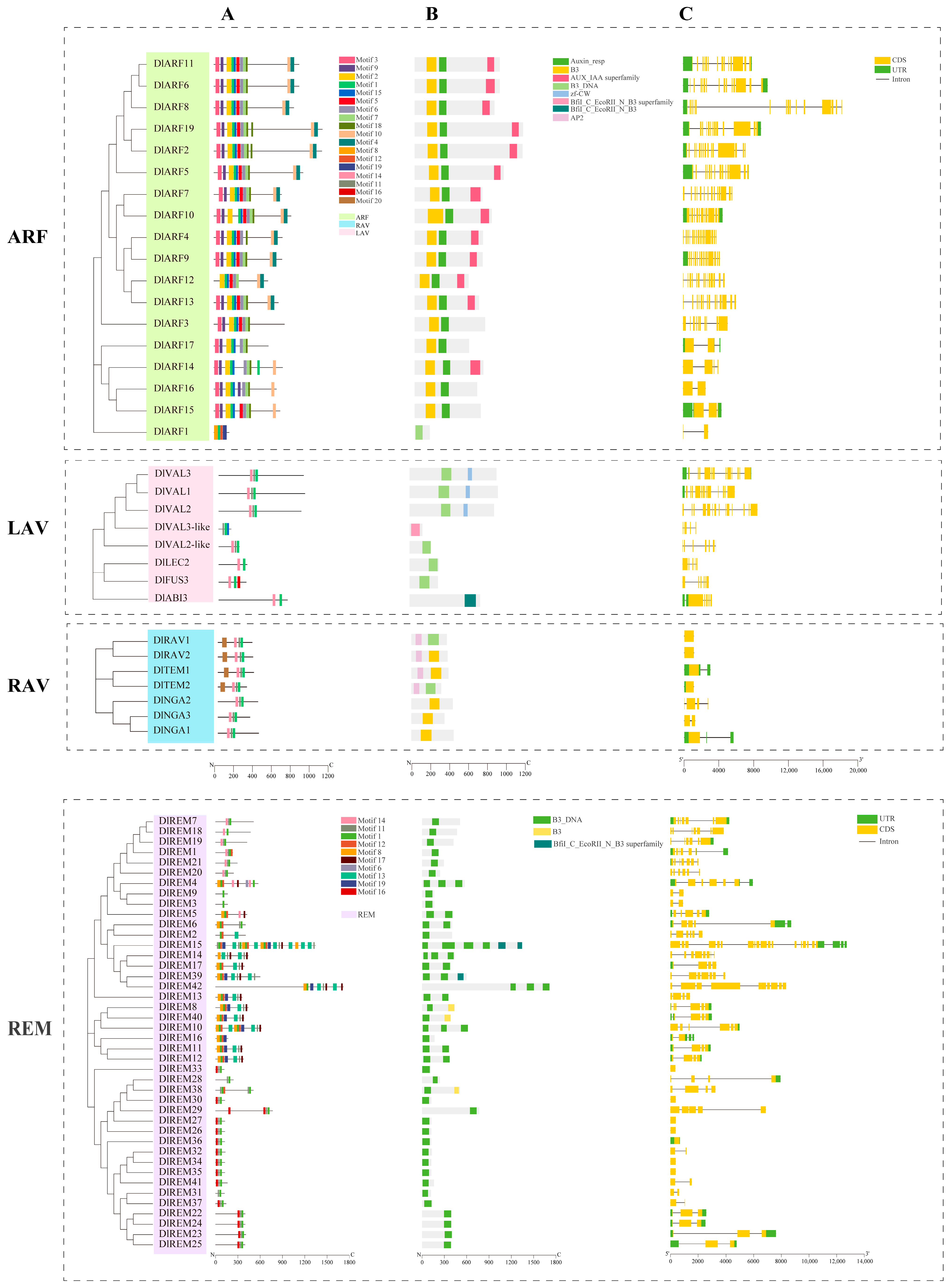
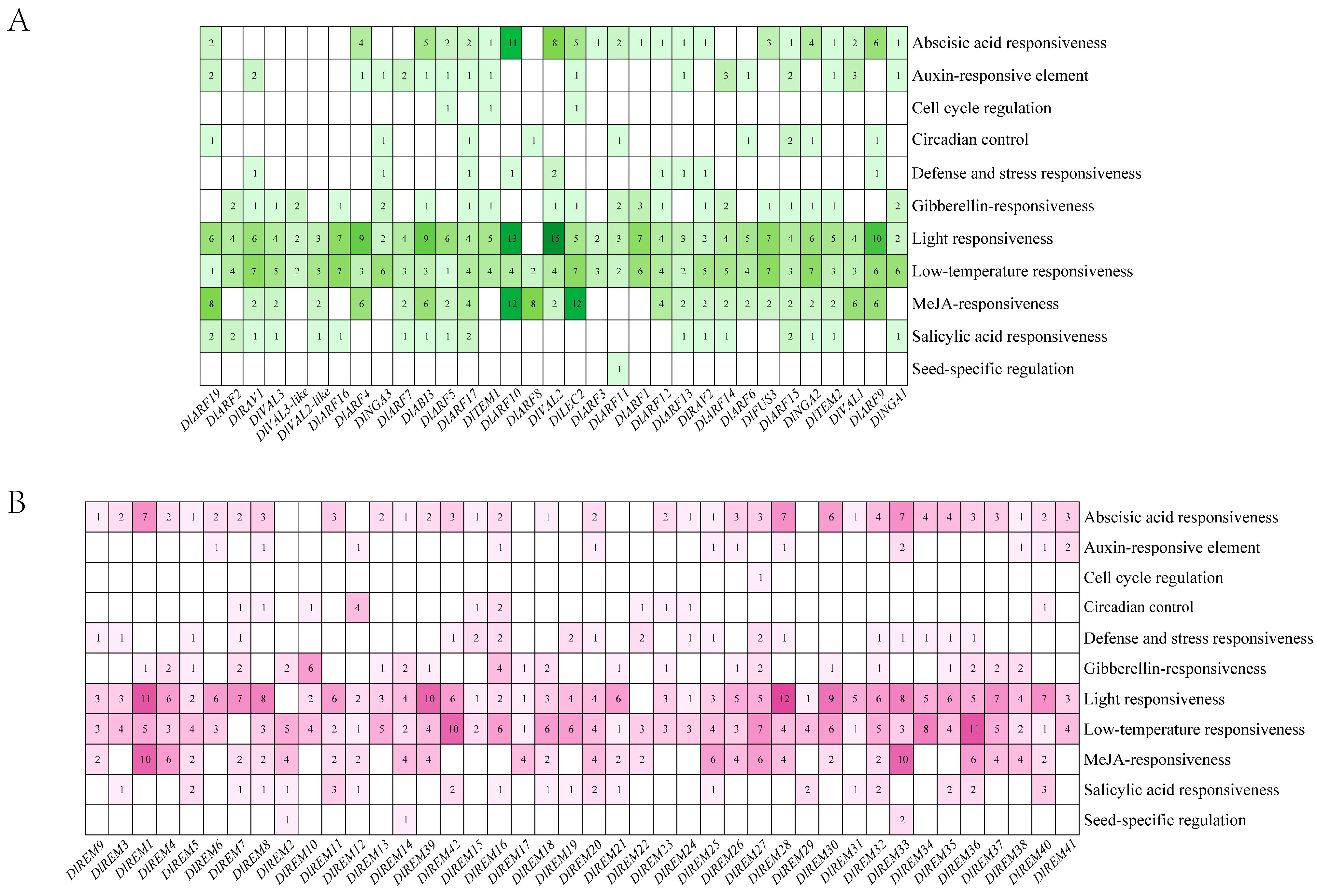
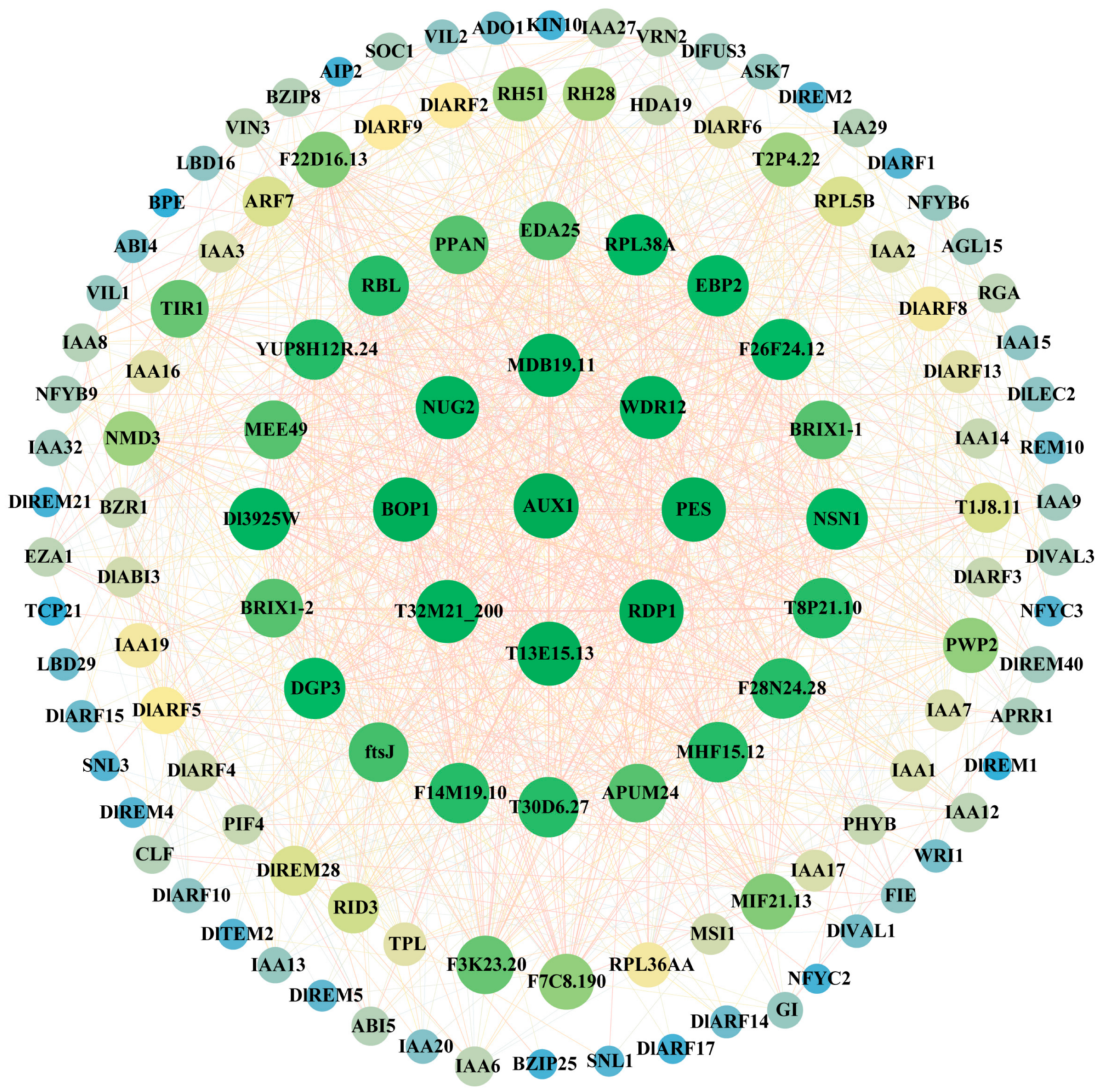
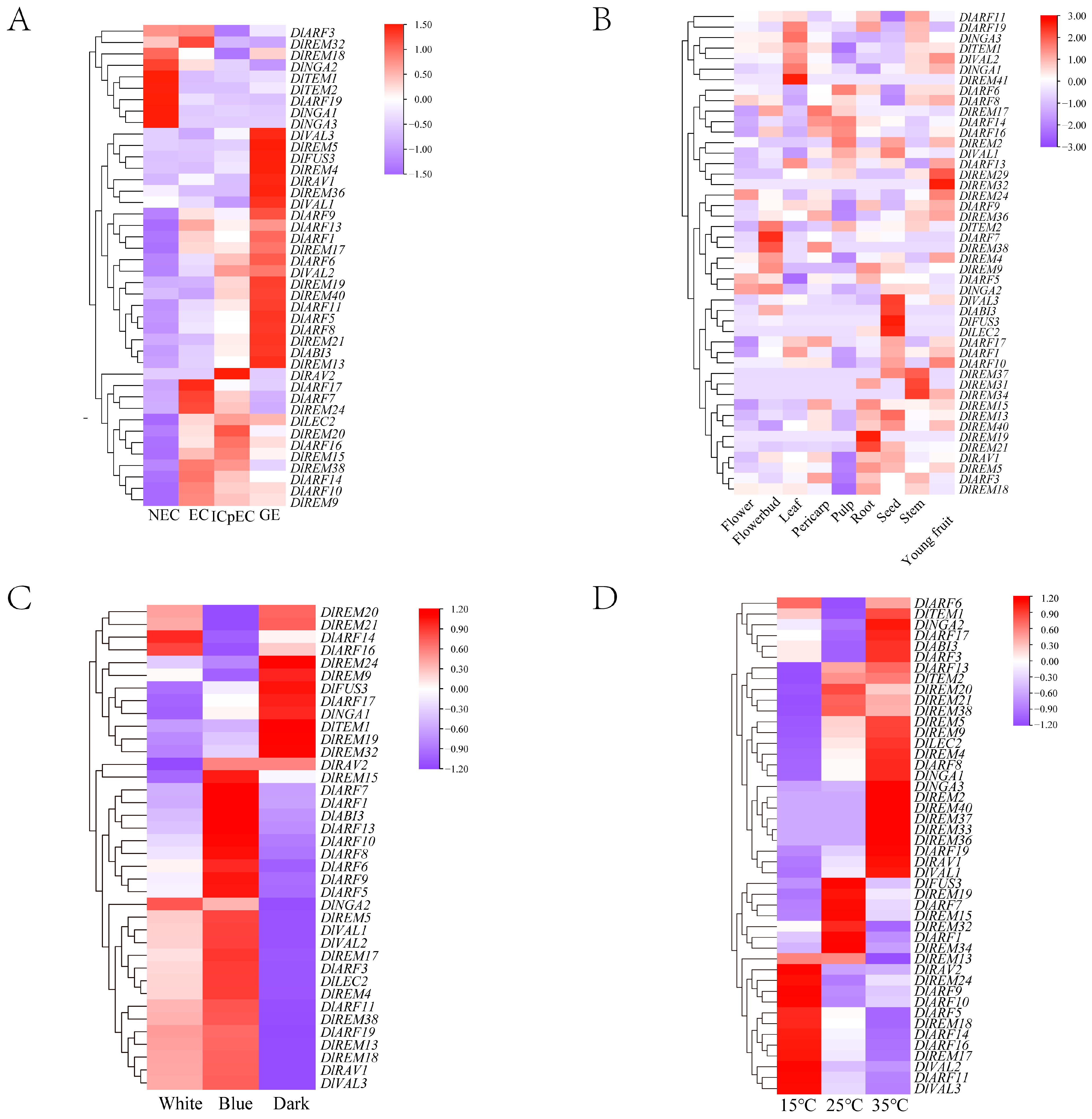



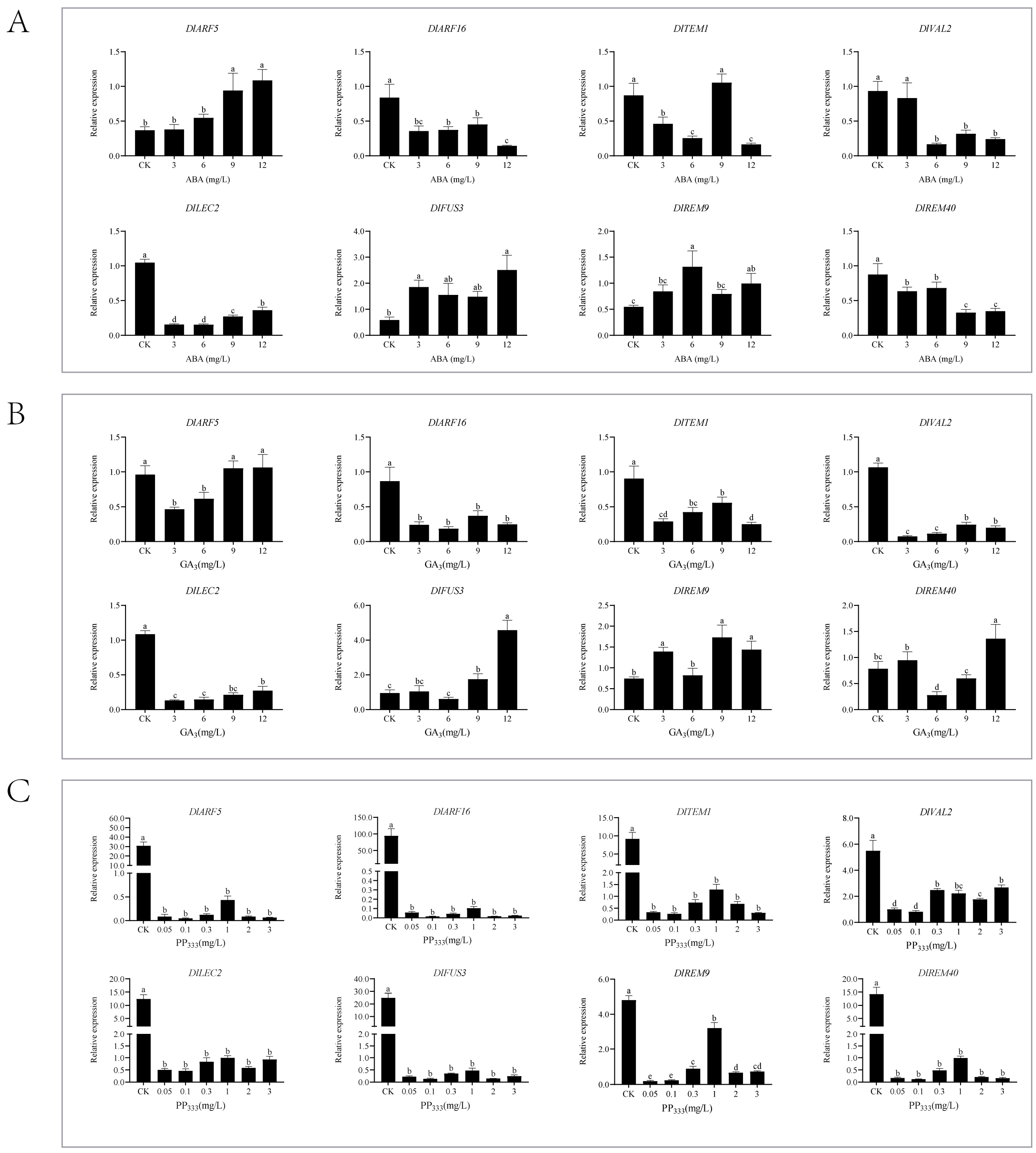
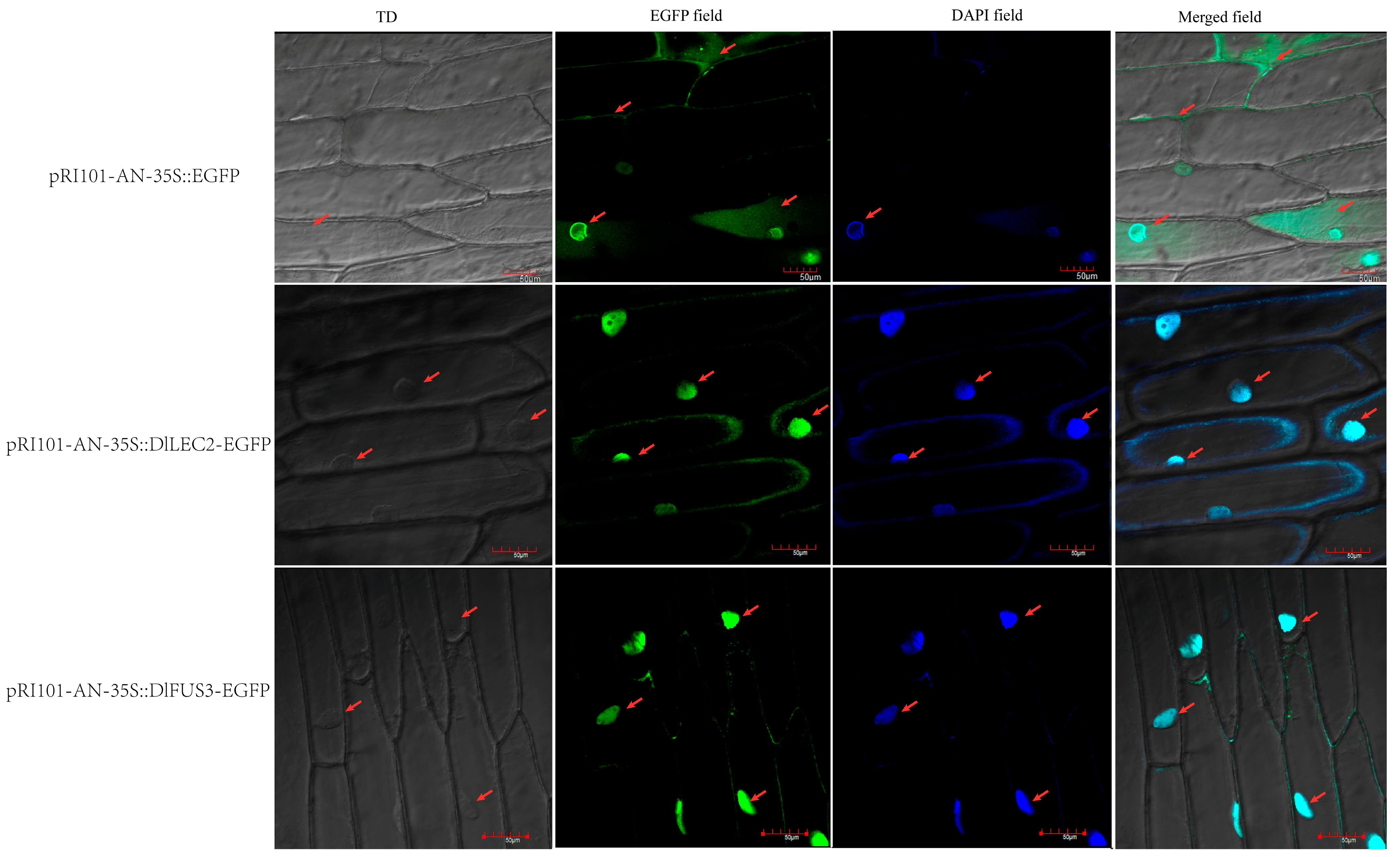
| Gene ID | Gene Name | Number of Amino Acids | Molecule Weight/kD | pI | Instability Index | Grand Average of Hydropathicity | Subcellular Localization |
|---|---|---|---|---|---|---|---|
| Dlo023441 | DlARF1 | 160 | 18,294.66 | 5.94 | 32.43 | −0.490 | Nucleus |
| Dlo001212 | DlARF2 | 1141 | 126,748.28 | 6.28 | 63.42 | −0.549 | Nucleus |
| Dlo021672 | DlARF3 | 745 | 80,871.67 | 6.61 | 53.59 | −0.366 | Nucleus |
| Dlo011752 | DlARF4 | 723 | 80,752.32 | 6.63 | 52.54 | −0.480 | Nucleus |
| Dlo013412 | DlARF5 | 942 | 104,338.60 | 5.27 | 53.55 | −0.420 | Nucleus |
| Dlo027446 | DlARF6 | 900 | 99,373.37 | 5.89 | 64.53 | −0.404 | Nucleus |
| Dlo012202 | DlARF7 | 715 | 79,496.01 | 8.08 | 54.59 | −0.483 | Nucleus |
| Dlo020967 | DlARF8 | 844 | 94,263.26 | 6.09 | 58.42 | −0.453 | Nucleus |
| Dlo032463 | DlARF9 | 719 | 80,129.41 | 6.51 | 58.48 | −0.501 | Nucleus |
| Dlo019051 | DlARF10 | 815 | 91,040.33 | 6.72 | 51.55 | −0.445 | Peroxisome |
| Dlo022003 | DlARF11 | 900 | 99,758.53 | 6.28 | 67.00 | −0.448 | Nucleus |
| Dlo024135 | DlARF12 | 570 | 63,745.78 | 5.98 | 61.96 | −0.564 | Nucleus |
| Dlo024139 | DlARF13 | 681 | 75,729.25 | 6.00 | 61.50 | −0.536 | Nucleus |
| Dlo026194 | DlARF14 | 726 | 79,376.64 | 7.21 | 47.76 | −0.300 | Nucleus |
| Dlo029423 | DlARF15 | 699 | 77,102.47 | 6.58 | 51.23 | −0.378 | Nucleus |
| Dlo011149 | DlARF16 | 661 | 72,724.67 | 6.48 | 45.94 | −0.432 | Nucleus |
| Dlo013583 | DlARF17 | 575 | 63,536.36 | 5.76 | 49.60 | −0.350 | Chloroplast |
| Dlo000294 | DlARF18 | 1146 | 127,790.65 | 6.16 | 73.08 | −0.668 | Nucleus |
| Dlo030448 | DlVAL1 | 909 | 99,933.47 | 7.27 | 51.27 | −0.639 | Nucleus |
| Dlo021533 | DlVAL2 | 870 | 95,938.90 | 7.85 | 52.99 | −0.702 | Nucleus |
| Dlo008782 | DlVAL2-like | 220 | 24,623.14 | 6.52 | 29.32 | −0.430 | Nucleus |
| Dlo007002 | DlVAL3 | 895 | 98,661.78 | 6.13 | 51.50 | −0.658 | Nucleus |
| Dlo008781 | DlVAL3-like | 131 | 15,276.82 | 9.14 | 19.37 | −0.18 | Cytoplasm |
| Dlo021632 | DlLEC2 | 301 | 34,110.3 | 9.44 | 41.22 | −0.662 | Nucleus |
| Dlo027511 | DlFUS3 | 292 | 32,766.84 | 5.91 | 36.95 | −0.425 | Nucleus |
| Dlo012591 | DlABI3 | 726 | 81,352.54 | 6.41 | 59.52 | −0.782 | Nucleus |
| Dlo001570 | DlRAV1 | 349 | 40,620.69 | 8.92 | 8.92 | −0.778 | Nucleus |
| Dlo025742 | DlRAV2 | 357 | 40,982.28 | 8.74 | 39.47 | −0.682 | Nucleus |
| Dlo018238 | DlTEM1 | 365 | 40,248.54 | 9.10 | 44.13 | −0.523 | Nucleus |
| Dlo030061 | DlTEM2 | 293 | 33,555.67 | 6.83 | 48.96 | −0.675 | Nucleus |
| Dlo032565 | DlNGA1 | 416 | 47,484.71 | 6.68 | 58.23 | −0.862 | Nucleus |
| Dlo029723 | DlNGA2 | 408 | 46,538.25 | 6.55 | 58.48 | −0.924 | Nucleus |
| Dlo011844 | DlNGA3 | 326 | 36,539.38 | 5.49 | 51.70 | −0.798 | Nucleus |
| Dlo014151 | DlREM1 | 231 | 26,084.03 | 9.84 | 57.82 | −0.490 | Chloroplast |
| Dlo023420 | DlREM2 | 403 | 46,286.78 | 6.34 | 60.32 | −0.961 | Chloroplast |
| Dlo004569 | DlREM3 | 162 | 18,503.16 | 7.66 | 51.14 | −0.531 | Nucleus |
| Dlo014215 | DlREM4 | 573 | 64,449.58 | 9.06 | 43.98 | −0.388 | Peroxisome |
| Dlo014216 | DlREM5 | 422 | 47,100.77 | 8.71 | 38.46 | −0.244 | Cytoplasm |
| Dlo014217 | DlREM6 | 402 | 46,348.13 | 9.77 | 45.32 | −0.812 | Nucleus |
| Dlo015857 | DlREM7 | 510 | 57,348.01 | 6.24 | 49.93 | −0.599 | Nucleus |
| Dlo022556 | DlREM8 | 440 | 50,988.45 | 8.88 | 34.69 | −0.504 | Cytoplasm |
| Dlo004420 | DlREM9 | 162 | 18,559.08 | 5.93 | 53.58 | −0.615 | Nucleus |
| Dlo023431 | DlREM10 | 616 | 71,420.96 | 9.07 | 41.80 | −0.528 | Chloroplast |
| Dlo023432 | DlREM11 | 367 | 41,658.73 | 9.02 | 29.52 | −0.526 | Nucleus |
| Dlo023433 | DlREM12 | 377 | 42,787.88 | 8.66 | 35.20 | −0.503 | Chloroplast |
| Dlo023434 | DlREM13 | 358 | 41,439.44 | 5.43 | 43.25 | −0.733 | Nucleus |
| Dlo023435 | DlREM14 | 439 | 49,915.2 | 8.36 | 43.19 | −0.398 | Cytoplasm |
| Dlo023438 | DlREM15 | 1345 | 154,205.5 | 8.40 | 43.30 | −0.475 | Nucleus |
| Dlo023439 | DlREM16 | 167 | 19,228.83 | 6.42 | 37.48 | −0.517 | Cytoplasm |
| Dlo023442 | DlREM17 | 388 | 44,423.1 | 9.31 | 38.96 | −0.570 | Nucleus |
| Dlo023498 | DlREM18 | 470 | 53,169.43 | 6.70 | 39.93 | −0.530 | Nucleus |
| Dlo023499 | DlREM19 | 422 | 48,083.66 | 4.92 | 41.09 | −0.443 | Nucleus |
| Dlo023500 | DlREM20 | 242 | 28,237.77 | 9.37 | 58.48 | −1.067 | Nucleus |
| Dlo023501 | DlREM21 | 293 | 33,976.05 | 6.34 | 65.33 | −0.879 | Nucleus |
| Dlo024128 | DlREM22 | 397 | 45,082.71 | 4.83 | 30.41 | 0.030 | Plasma membrane |
| Dlo024132 | DlREM23 | 406 | 45,600.43 | 4.50 | 32.55 | −0.101 | Plasma membrane |
| Dlo024182 | DlREM24 | 397 | 44,966.33 | 4.72 | 27.44 | −0.002 | Plasma membrane |
| Dlo024185 | DlREM25 | 395 | 44,420.04 | 4.54 | 33.52 | −0.162 | Plasma membrane |
| Dlo024514 | DlREM26 | 124 | 14,588.86 | 10.04 | 41.36 | −0.552 | Mitochondrion |
| Dlo024515 | DlREM27 | 125 | 14,499.78 | 9.93 | 40.53 | −0.442 | Mitochondrion |
| Dlo024518 | DlREM28 | 240 | 26,941.38 | 9.58 | 38.23 | −0.193 | Nucleus |
| Dlo024524 | DlREM29 | 767 | 88,189.41 | 9.31 | 41.63 | −0.218 | Chloroplast |
| Dlo024536 | DlREM30 | 124 | 14,289.6 | 9.88 | 34.58 | −0.440 | Chloroplast |
| Dlo024545 | DlREM31 | 120 | 13,677.86 | 9.45 | 43.74 | −0.269 | Nucleus |
| Dlo024552 | DlREM32 | 131 | 15,368.62 | 10.85 | 37.20 | −0.458 | Cytoplasm |
| Dlo024555 | DlREM33 | 116 | 13,414.94 | 10.00 | 31.16 | −0.334 | Cytoplasm |
| Dlo024557 | DlREM34 | 124 | 14,469.44 | 9.62 | 41.69 | −0.531 | Chloroplast |
| Dlo024558 | DlREM35 | 124 | 14,621.62 | 9.79 | 41.57 | −0.563 | Chloroplast |
| Dlo024600 | DlREM36 | 123 | 14,476.87 | 10.50 | 32.73 | −0.742 | Cytoplasm |
| Dlo024601 | DlREM37 | 142 | 16,080.3 | 7.05 | 56.77 | −0.407 | Chloroplast |
| Dlo031919 | DlREM38 | 508 | 56,502.05 | 5.40 | 42.81 | −0.358 | Nucleus |
| Dlo023436 | DlREM39 | 599 | 68,600.67 | 8.54 | 43.88 | −0.525 | Nucleus |
| Dlo032704 | DlREM40 | 383 | 44,610.98 | 9.11 | 35.64 | −0.606 | Cytoplasm |
| Dlo033608 | DlREM41 | 159 | 18,004.63 | 9.91 | 44.71 | −0.561 | Nucleus |
| Dlo023437 | DlREM42 | 1719 | 192,573.79 | 9.24 | 44.13 | −0.394 | Chloroplast |
Disclaimer/Publisher’s Note: The statements, opinions and data contained in all publications are solely those of the individual author(s) and contributor(s) and not of MDPI and/or the editor(s). MDPI and/or the editor(s) disclaim responsibility for any injury to people or property resulting from any ideas, methods, instructions or products referred to in the content. |
© 2023 by the authors. Licensee MDPI, Basel, Switzerland. This article is an open access article distributed under the terms and conditions of the Creative Commons Attribution (CC BY) license (https://creativecommons.org/licenses/by/4.0/).
Share and Cite
Tang, M.; Zhao, G.; Awais, M.; Gao, X.; Meng, W.; Lin, J.; Zhao, B.; Lai, Z.; Lin, Y.; Chen, Y. Genome-Wide Identification and Expression Analysis Reveals the B3 Superfamily Involved in Embryogenesis and Hormone Responses in Dimocarpus longan Lour. Int. J. Mol. Sci. 2024, 25, 127. https://doi.org/10.3390/ijms25010127
Tang M, Zhao G, Awais M, Gao X, Meng W, Lin J, Zhao B, Lai Z, Lin Y, Chen Y. Genome-Wide Identification and Expression Analysis Reveals the B3 Superfamily Involved in Embryogenesis and Hormone Responses in Dimocarpus longan Lour. International Journal of Molecular Sciences. 2024; 25(1):127. https://doi.org/10.3390/ijms25010127
Chicago/Turabian StyleTang, Mengjie, Guanghui Zhao, Muhammad Awais, Xiaoli Gao, Wenyong Meng, Jindi Lin, Bianbian Zhao, Zhongxiong Lai, Yuling Lin, and Yukun Chen. 2024. "Genome-Wide Identification and Expression Analysis Reveals the B3 Superfamily Involved in Embryogenesis and Hormone Responses in Dimocarpus longan Lour." International Journal of Molecular Sciences 25, no. 1: 127. https://doi.org/10.3390/ijms25010127
APA StyleTang, M., Zhao, G., Awais, M., Gao, X., Meng, W., Lin, J., Zhao, B., Lai, Z., Lin, Y., & Chen, Y. (2024). Genome-Wide Identification and Expression Analysis Reveals the B3 Superfamily Involved in Embryogenesis and Hormone Responses in Dimocarpus longan Lour. International Journal of Molecular Sciences, 25(1), 127. https://doi.org/10.3390/ijms25010127








